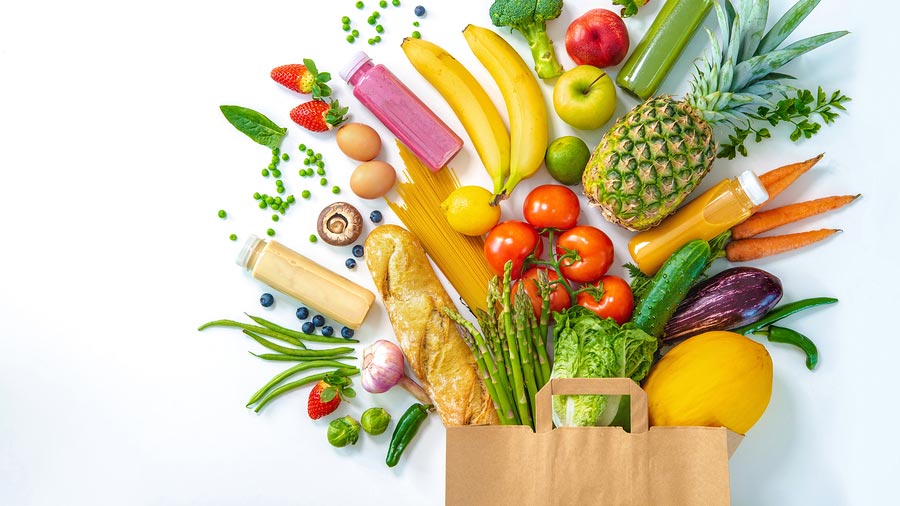
Many Australians live with insulin resistance for years before it’s diagnosed – it generally starts silently and can progress with very few symptoms. If left unchecked, insulin resistance can develop into pre-diabetes, and eventually type two diabetes. Contrary to popular belief, insulin resistance is reversible and does not automatically mean a person will develop prediabetes or type two diabetes. In fact, it can be a very timely warning sign and a great time to reflect on your diet and lifestyle and make some improvements. With even just a few lifestyle changes, it’s possible to reverse insulin resistance, regain your energy, get a hold of your sugar cravings and lower your risk of many lifestyle related diseases.
What is insulin resistance?
When we eat carbohydrates, the body digests them and breaks them down into glucose, a type of sugar. Carbohydrate foods include things like fruit, starchy vegetables (potato, sweet potato, corn), bread, rice, pasta, noodles, legumes (chickpeas, beans, lentils) and any foods rich in sugar and/or flour such as cakes, biscuits, chocolate, lollies and soft-drink.
Glucose is the preferred source of energy in the body, but it relies on a hormone called insulin to carry the glucose out of the bloodstream and move it into your cells. In insulin resistance, the body’s cells ignore or ‘resist’ some of the insulin’s efforts which means that instead of the sugar being transported into your cells, it stays in the bloodstream. Your body then tries to compensate by producing more insulin to manage your blood sugar levels.
What are the risk factors?
- >> Being overweight, particularly around the abdomen
- >> Physical inactivity
- >> Polycystic Ovary Syndrome (PCOS)
- >> Smoking
- >> High blood pressure
- >> Family history of Type Two Diabetes
- >> History of gestational diabetes
- >> History of heart disease or stroke
- >> Metabolic syndrome- when you have a combination of high blood pressure, abnormal cholesterol levels and excess body fat carried around the mid-section
- >> Fatty liver disease
- >> Poor sleep or sleeping issues
What can you do?
Fat loss: High levels of visceral fat, a dangerous hidden fat around your organs is a major driver of insulin resistance and type two diabetes. Even small amounts of weight loss as little as 5-10% have been shown to improve insulin resistance and blood sugar levels. Avoid crash dieting as you tend to mainly lose water and muscle and the chances of regaining it are 95%!
Reduce your intake of saturated fats: An excessive intake of total fat (>37% of daily energy intake) has been shown to reduce insulin sensitivity irrespective of the type of fat in the diet. Therefore, reducing the intake of excess fat from a diet is assumed to be beneficial. But does the type of fat matter? Studies of populations show a relationship between the intake of saturated fats and the incidence of insulin resistance and type two diabetes. This may be due to an increase in inflammation and intramyocellular lipid content. Sources of saturated fat include animal fat from beef, pork, lamb and chicken, high-fat dairy foods such as butter, full-fat milk, cheese, sour cream and ice-cream and oils such as coconut oil, palm oil, cocoa butter and lard. Replacing these saturated fats with monounsaturated fats may improve insulin resistance. Good sources of monounsaturated fats include avocados, almonds, cashews and peanuts and extra-virgin olives oil, rice bran oil and sesame oil.
Prioritise your sleep: The main reason that inadequate sleep can affect your insulin resistance is that it throws your hormone levels out of whack. Data from large studies have shown that short-sleep duration in middle-aged to elderly subjects is associated with an increased risk of type two diabetes and prediabetes as well as increased insulin and blood sugar levels and worsening insulin resistance. In fact in patients who have Type Two Diabetes, inadequate sleep has been shown to worsen blood sugar control. Studies have also shown that when people who do not get enough sleep are more likely to eat more, exercise less, and be overweight.
Load up on plants! Plant-based diets are eating patterns that favour plant foods such as legumes, whole-grains, vegetables, fruits, nuts, and seeds and limit or avoid most or all animal products. Numerous population studies strongly support the role of plant-based diets in reducing the risk of developing type two diabetes with vegans following a whole-food plant-based shown to have dramatically lower risk of developing type 2 diabetes compared with non-vegetarians.
Diets based on whole plant foods not only include foods which protect against insulin resistance and diabetes, but they simultaneously exclude animal-based foods that tend to promote insulin resistance, particularly processed (think sausages, deli meats and bacon) and unprocessed red meat.
Studies have shown that eating plans higher in dietary fibre (which comes exclusively from plants) have a moderating effect on blood glucose levels. One great way to up your fibre intake (along with a whole host of other nutrients) is to embrace the veggie-loving life!
- Start your day with a green smoothie: add ½ a frozen banana, 1 cup of coconut water, 1 cup of baby spinach, ¼ avocado and ½ cup of frozen mango
- Introduce 2-3 vegan meals per week such as a tofu stir-fry, chickpea curry, roast vegetable salad, vegetable burgers or home made baked beans on seeded bread
- Snack on veggies between meals such as carrots, celery, baby cucumbers and capsicum
- Include 1-2 cups of salad or vegetables with each main meal
- Keep some frozen veggies in the freezer for those times when you’re out of fresh vegetables
- Aim for three different coloured vegetables or salad with each meal
Choose low GI carbohydrates: Carbohydrate is an essential part of our diets, but not all carbohydrate foods are equal. The Glycemic Index (GI) refers to how quickly a carbohydrate food is broken down into sugar in the body and released into the bloodstream. Carbohydrates with a low GI value (55 or less) are more slowly digested, absorbed and processed in the body and cause a lower and slower rise in blood glucose and, therefore usually, insulin levels. Low GI foods have been shown to be beneficial for managing your weight and reducing your risk of type two diabetes. They’re also beneficial for helping people manage their blood glucose levels and reducing insulin resistance.
Examples of low GI foods include:
Fruit: Kiwifruit, berries, Grapefruit, peach, apricot, apple, pear, plum, orange, grapes, banana, cherries, mango
Vegetables: Legumes, sweet potato, butternut pumpkin,
Rice: Sunrice Doongara or low GI rice, black rice, wild rice, quinoa and chia rice blends
Wholegrains: Quinoa, buckwheat, barley
Pasta: Durum Wheat Pasta Cooked ‘Al Dente
Noodles: soba noodles, vermicelli noodles, buckwheat noodles
Bread: Good quality seeded bread or traditional sour-dough bread
Cereals: Traditional rolled oats, natural muesli
Crackers: Seed and grain crackers e.g. Ryvitas or vitaweats
Move your body
While taking control of what you’re eating is a great way to manage insulin levels, you can also help your body out by moving more. A combination of strength exercise (using your own body or weights) and cardiovascular exercise is most effective for insulin resistance and blood sugar control. Exercise should be performed at least three days per week with no more than two consecutive days without exercise. The intensity should be moderate to intense and this is different from person to person. We know that exercise improves insulin sensitivity i.e. it makes the body’s cells more receptive to the hormone insulin. Insulin sensitivity however declines significantly by 48 hours post exercise which is why it is important to be consistent with exercise. Increased frequency of exercise is also a wonderful way to lower blood sugar levels. Regular exercise along with a healthy diet may also promote healthy weight loss and an increase in muscle mass, two factors which improve insulin resistance.
Try your best to reduce your sedentary time. This can be especially hard for those working in an office environment but scheduling in regular mini-breaks to move and stretch, or a lunchtime walk can make a big difference.
To speak to Eatsense Dietitians head to our contact us page
